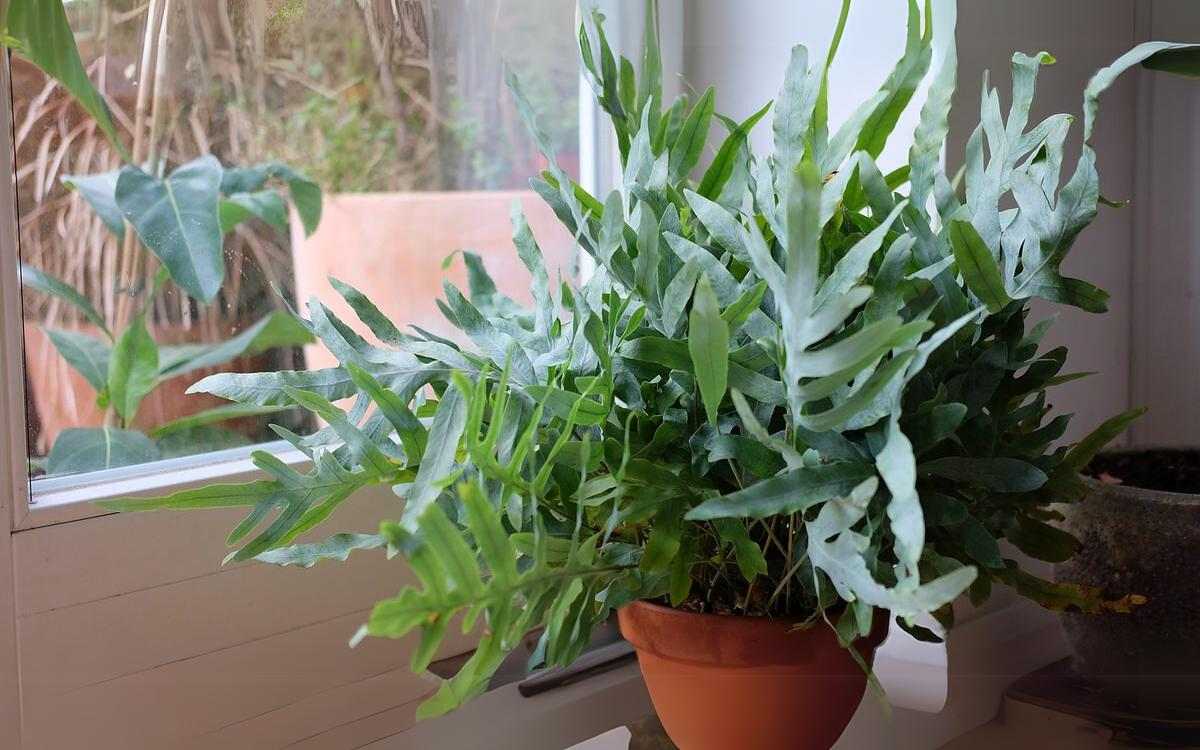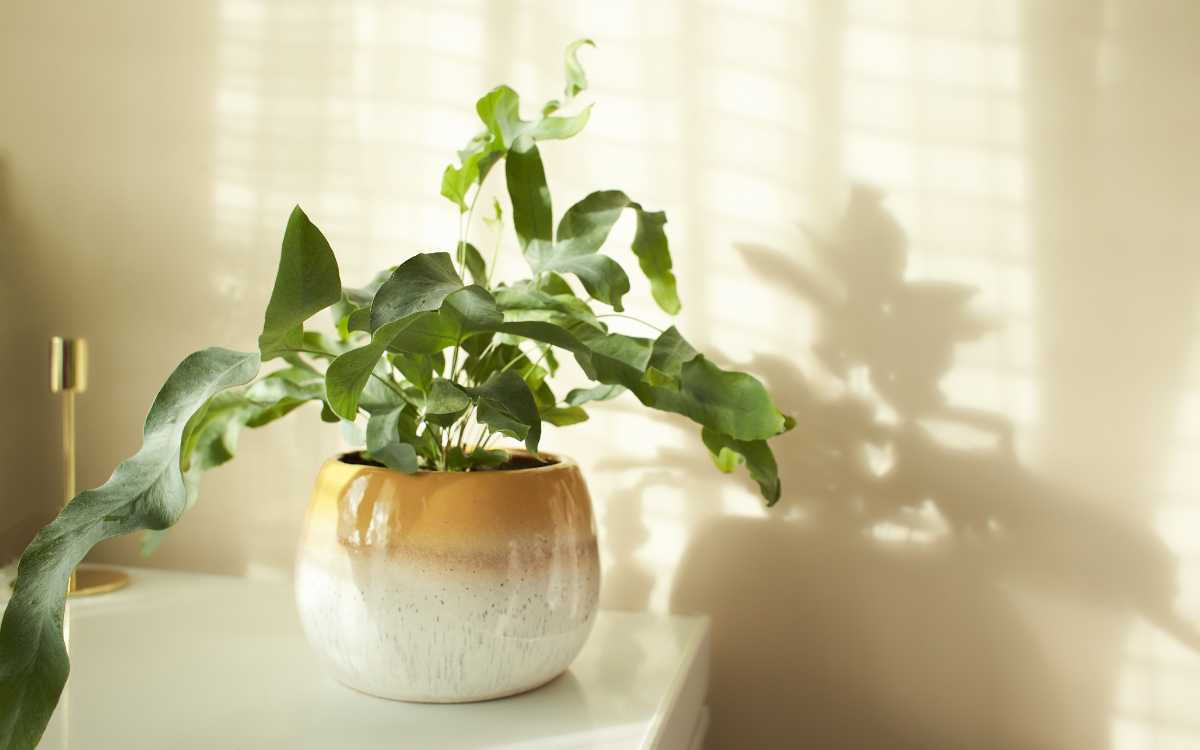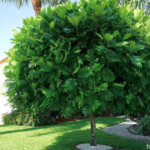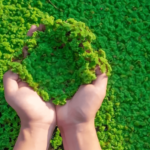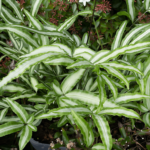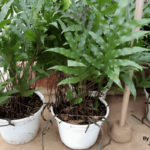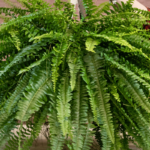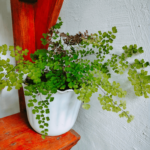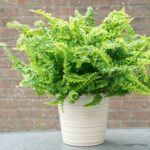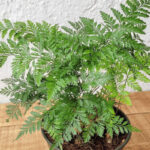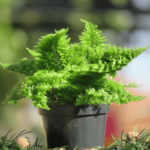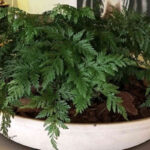A Phlebodium aureum, popularly known as Blue Fern, is a tropical plant native to the Americas (south of Florida, in the Bahamas, Central America, and parts of South America).
Its leaves can reach up to 1 meter (3.3 feet) in height and have a bluish-gray coloration due to the fine layer of wax on the leaf surface. This tone is the result of the interaction between sunlight and the chemical composition of the wax.
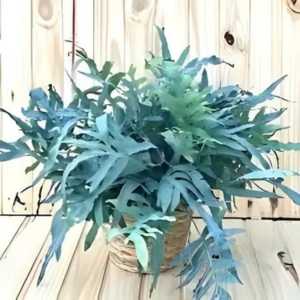
The rhizomes of the Blue Fern are covered by fine hairs, and the plant can develop terrestrially or epiphytically, adapting well to different environments.
The Blue Fern is capable of purifying the air by removing toxins present in the environment.
Although it can grow in various environments, this fern is sensitive to cold, especially frost, so it may not be a good choice if you live in areas with harsh winters.
Uses and Where to Place
The Blue Fern (Phlebodium aureum) is versatile and can stand out in both indoor and outdoor environments.
Inside homes and apartments, the Blue Fern can be placed in various locations, from winter gardens to shelves near windows, where it will receive indirect light for a few hours a day.
It is ideal to place it in environments with good humidity, such as kitchens and bathrooms, or near humidifiers, to ensure that the soil remains consistently moist.
The plant can also be used as a hanging element, either alone or in composition with other indoor plants, such as orchids. Its bluish-gray foliage provides an ornamental effect that complements various styles of decor, bringing a natural and relaxing touch to the environment.
In outdoor areas, the Blue Fern can be planted in gardens and patios with partial shade and indirect light.
It can also be cultivated as an epiphyte, attached to trees or similar structures, as long as it is not exposed directly to the sun and is kept moist and well-drained.
Ideal Climate
Now that you’ve learned a bit about where to place your Blue Fern to grow it healthily, I’ll explain a bit more about its ideal climate.
The Blue Fern prefers filtered or indirect light and does not tolerate direct sun exposure, especially during the hottest hours of the day. Direct sunlight can cause leaf burns and compromise the plant’s health.
The ideal temperature for growing the Blue Fern ranges from 16°C to 24°C (61°F to 75°F). It should be protected from very low temperatures and from cold or hot drafts, which can hinder its development.
Regarding humidity, this is a plant that likes consistently moist soil (but not waterlogged) and moderate to high ambient humidity.
Read too:
- Maidenhair fern (Adiantum spp.) – Care Guide
- Ribbon Fern or Cretan Brake Fern: How to Plant and Care
- Japanese Fern Tree – How to Care and Characteristics
- How to Care for Ferns in 9 Steps (For Beginners)
Ideal Soil
Choosing good soil for your plant’s development will help ensure easier cultivation and a healthier plant. Below are some tips that might help you.
For the Blue Fern, the soil should be rich in organic matter, well-drained, and slightly acidic.
A suitable mix can be composed of regular garden soil, peat, and sand, each playing an important role in soil health:
- Regular Garden Soil: Provides the base of the substrate, offering structural support and essential nutrients.
- Peat: Rich in organic matter, it increases the soil’s moisture retention capacity, essential for keeping the roots hydrated without waterlogging.
- Sand: Promotes good drainage, preventing the roots from being submerged in water, which can lead to rot.
An ideal pH in the range of 5.5 to 6.5 is optimal. Excessively acidic or alkaline soils can negatively affect the plant’s growth, compromising nutrient absorption.
How to Water
The Blue Fern prefers the soil to be always moist but never waterlogged. Watering should be done whenever the soil is slightly dry to the touch.
It is important to avoid letting the soil dry out completely between waterings.
However, too much water can be as harmful as too little, as it can lead to root rot.
When watering your fern, try to avoid wetting the leaves, directing the water only to the soil and roots, which will help prevent diseases.
How to Fertilize
To fertilize correctly, you need to understand the types of fertilizers for your fern and how often to apply them.
First, see below the main fertilizer options:
- Liquid Fertilizer: Can be diluted in watering, ensuring an even distribution of nutrients in the soil. The dilution should follow the manufacturer’s instructions to avoid excessive fertilizer concentration.
- Slow-Release Solid Fertilizer: This type of fertilizer provides nutrients over time, reducing the risk of over-fertilization and providing continuous nourishment to the plant.
Fertilization Frequency:
- The Blue Fern should be fertilized during active growth periods, which typically occur from spring to summer. During these months, fertilization can be done every two months.
- In winter, the plant enters a dormant period, and fertilization should be reduced or avoided to avoid overloading the soil with unnecessary nutrients.
Planting and Replanting
Now that you’ve learned the main care necessary to keep your Blue Fern healthy, you’ll be able to plant or replant it easily.
- Choose the soil mix (already covered)
- Choose the pot (the pot should be spacious enough to accommodate the roots and allow the plant to grow. The Blue Fern can be planted alone or in groups with other plants. It is important that the pot has drainage holes to prevent water accumulation)
- Pot Preparation: Place a layer of stones or ceramic shards at the bottom of the pot to improve drainage.
- Add the chosen substrate
- Plant Positioning: Place the Blue Fern in the center of the pot, gently spreading the roots over the substrate. Do not bury the rhizome; it should remain slightly above the soil surface.
- Cover with Substrate: Fill the pot with the remaining substrate, pressing lightly to secure the plant.
Regarding replanting, it should be done every 2 or 3 years when the roots start to come out of the drainage holes. The ideal time for replanting is in the spring or summer.
To replant, remove your Blue Fern from the old pot (carefully to avoid damaging the roots), then clean the roots of the old substrate and follow the steps above to plant it in the new pot.
Recommended articles:
- Leatherleaf fern – Care, Characteristics and Curiosities
- Monarch Fern – How to Care and Propagate
- Marisa Fern: 7-Step Growing and Care Guide
- Rabbit’s Foot Fern (Davallia fejeensis): Cultivation Guide
Multiplication
The simplest way to multiply the Blue Fern (Phlebodium aureum) is by dividing the rhizomes.
This process involves dividing the rhizome into smaller sections, ensuring that each section has healthy roots and leaves.
The division should be done carefully to avoid damaging the roots.
- Choose the Ideal Time: The division should be done during the plant’s growing period, which occurs in the spring and summer.
- Remove the Plant: Remove the plant from the pot, holding the base of the leaves and loosening the substrate around the roots.
- Divide the Rhizomes: Using a sharp, sterilized knife, cut the rhizome into sections. Each section should have at least one growth point and roots.
- Plant the Sections: Plant each section in a new pot with a suitable substrate.
- Post-Planting Care: Water lightly and place the pots in a location with bright indirect light.
Pests, Diseases, and Other Problems
Although it is a resilient plant, the Blue Fern can have problems with pests, diseases, or cultivation errors, so below I will share with you the main obstacles that may arise in the cultivation of this plant.
1. Excess Water:
One of the main causes of problems in the Blue Fern is excess water, which can lead to root rot and fungal diseases. To avoid this:
- Use well-drained substrate and avoid waterlogging the soil.
- Water the plant only when the soil surface is dry to the touch and avoid accumulating water in the pot saucer.
2. Mealybugs:
Mealybugs are sap-sucking insects that can attach to the foliage and weaken the plant. To control them:
- Regularly check the leaves and stems to detect mealybugs early.
- Apply a suitable insecticide to eliminate mealybugs. Neem oil-based products are also effective.
3. Mites:
Mites can affect the Blue Fern, especially in dry and hot environments. They cause yellowish spots on the leaves. To control mites:
- Maintain high humidity levels by using a humidifier or misting the leaves with water.
- Apply an appropriate miticide to eliminate the mites.
4. Fungal Diseases:
Fungal diseases, such as root rot, can occur due to water accumulation in the soil. To prevent these diseases:
- Avoid overwatering and ensure that the pot has good drainage.
- If the plant shows signs of fungal infection, use an appropriate fungicide and remove the affected parts.
These are the main care tips to keep your Phlebodium aureum healthy for many years.
Throughout this text, I’ve shared links to some articles on this blog about other fern species that might interest you. If you want to learn about other plants, below are more articles I recommend reading.
- How to Grow and Care for Rhipsalis (Step-by-Step)
- Ranunculus: How to Grow and Care (With Photos)
- How to Grow and Care for Primrose Easily (Primula)
- Watermelon Peperomia: How to Grow and Care Easily
- Manacá: How to Care and Make Seedlings (With Photos)
Until next time, feel free to leave a comment if you have any questions.

